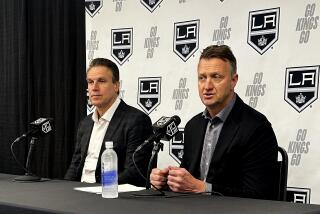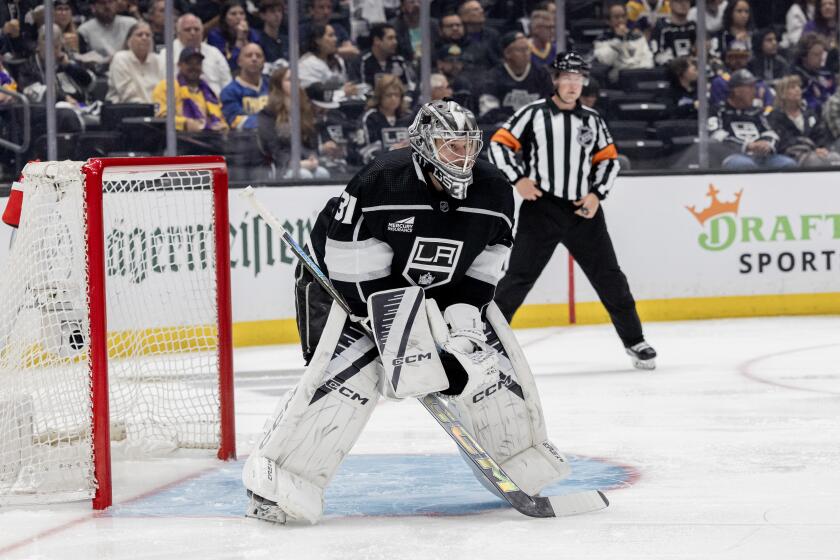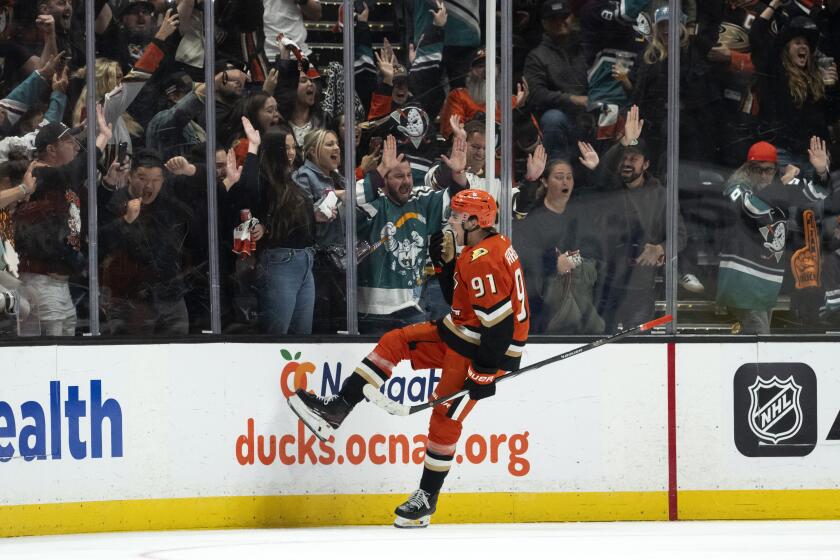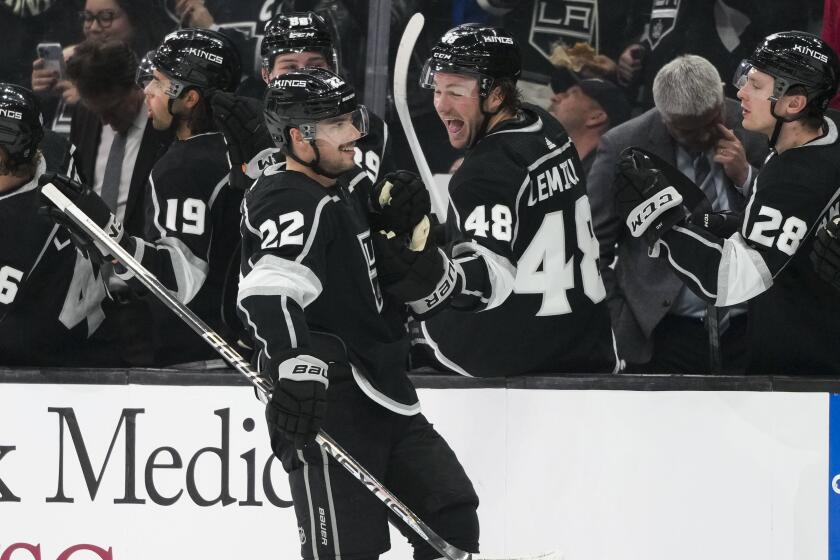Ferreira Is Getting Ready for Some Battles of His Own : NHL: With the draft just around the corner, Ducks general manager knows preparation is the key to success.
Not too far up the freeway from Jack Ferreira’s office near Disneyland, the Kings have been waging a battle for the right to play hockey in June--a chance at their first Stanley Cup.
Ferreira, general manager of the Mighty Ducks, is nearby in geography but thousands of miles away in purpose. He is preparing for his own crucial battles of June--the two drafts that will give Disney its first hockey players.
A month from today, on June 24, an assortment of NHL players officially will become Ducks or Florida Panthers after being selected in the expansion draft, which provides the two newest teams with players drawn from existing teams.
Two days later, the Ducks and Panthers will make their first selections in the NHL’s entry draft, the annual draft for all NHL teams.
As quickly as that, the Ducks will cease to be a faceless team-to-be and begin to become an actual team--a team that come October will begin playing actual games. A closer look at how the drafts will work:
Expansion Draft, June 24, Quebec City, Canada: This is the draft that will provide the new teams with the cores of their first rosters. Each of the existing 24 teams will be allowed to protect one goaltender, five defensemen and nine forwards. So the new teams, theoretically, will be choosing from among back-up goaltenders, sixth-best defensemen and fourth-line forwards.
It will be Ferreira’s second experience making expansion picks--he was general manager of the San Jose Sharks in 1991. The wisdom of his experience? Preparation means everything. Much of his time is being spent compiling lists of his best guesses on which players the 24 existing teams will protect, and working with assistant general manager Pierre Gauthier to shape draft strategies based on those lists. Why so much guessing before teams release their protected lists?
“We’re not going to get the final list until June 22 at 6 p.m.,” Ferreira said. “Then we’ll get less than 48 hours to decide how to do our draft.”
The plan, then, is to have a strategy in place, then adjust according to surprises on the list.
The great benefit of the guidelines for the new teams is that, for the first time since 1967, teams will be allowed to protect fewer than two goaltenders. That essentially guarantees the new teams a quality goaltender--a crucial factor in avoiding an overabundance of blowout losses.
Front-office executives with the new teams rub their hands when they look at the decisions facing teams such as Chicago, which has Ed Belfour and Jimmy Waite; St. Louis, which has a pretty good backup to Curtis Joseph in Guy Hebert; the New York Rangers, who have John Vanbiesbrouck and Mike Richter; Quebec, with veteran Ron Hextall and 22-year-old Stephane Fiset; and Vancouver, with Kirk McLean and Kay Whitmore. A coin flip just before the draft begins will give the winner--the Ducks or the Panthers--the right to decide whether to choose the first goaltender and not pick again until fourth, or to give away the first pick, but get the second and third.
Because each expansion team will chose three goaltenders, all the Ducks and Panthers must do is rate their top six in order, then react to the other team’s choices.
But as the draft continues by phases through defensemen and finally forwards, the choices will get tougher. That’s because each existing team will lose only two players. Some of those 13 forwards the Ducks select will be coming from Tampa Bay, Ottawa and San Jose.
“The philosophy on the expansion draft is that going into it you have to have two players from every team you’d be comfortable with,” Ferreira said. “Because the further you get into the draft, the more it becomes a matter of which teams haven’t had players taken, instead of which players you really want.”
There’s one more complication involving the expansion draft. It includes a secondary phase the next day, when the two new teams will protect one goaltender, five defensemen and 10 forwards among their 24 new players, then allow Tampa Bay, Ottawa and San Jose to take their turns making selections. The new teams can lose a maximum of three players, and will be able to replace them with any remaining unprotected player or with cash from the team that claimed their player.
Entry Draft, June 26, Quebec City: To the 24 existing teams, this is the real draft. Ottawa, San Jose and Tampa Bay will have the first three picks, with the Ducks and Panthers flipping a coin on draft day to decide which team picks fourth. The loser will pick fifth.
Next year, the Ducks and Panthers will have the privilege usually afforded first-year expansion teams--they’ll choose first and second.
While Ferreira will take the lead on the expansion draft, the entry draft will be headed by Gauthier, who formerly was chief scout with the Quebec Nordiques and was credited with such savvy selections as Owen Nolan, Mats Sundin and Joe Sakic.
Gauthier also has the experience of making one of the all-time easiest picks. He took Eric Lindros No. 1 in 1991, eventually leading to the blockbuster trade with Philadelphia that put the Nordiques on their feet.
Picking fourth or fifth isn’t quite as simple as picking Lindros No. 1, but the draft field is considered unusually deep, and Gauthier knows the Ducks will get a quality player.
Ferreira admits, however, that Gauthier told him he didn’t need to bother to scout Alexandre Daigle, the French-speaking center with Victoriaville of the Quebec Major Junior Hockey League who is rated No. 1 in the draft.
There are other outstanding prospects, though:
--Chris Pronger, a 6-foot-5 defenseman with Peterborough of the Ontario Hockey League.
--Chris Gratton, a 6-3, 200-pound center from Kingston of the OHL.
--Rob Niedermayer, a center with Medicine Hat of the Western Hockey League and the brother of the New Jersey Devils’ Scott Niedermayer.
--Paul Kariya, a center/right wing who was recognized as the best college player in the country this season when he won the Hobey Baker Award as a freshman for NCAA champion Maine.
--Viktor Kozlov, a Russian player whose talent might keep him high despite a disappointing season.
“We’re picking fourth or fifth, and we’ll have five names down in order,” Gauthier said. “One thing’s for sure, we’ll get a good player. Whoever it is, that’s fine.”
In other years, that wouldn’t have been the case. Gauthier points to 1989, when the Nordiques took Sundin with the No. 1 pick. The next four selections were Dave Chyzowski, Scott Thornton, Stu Barnes and Bill Guerin.
“That year was a total bust for a lot of teams,” Gauthier said. “This year is more like 1990, with Nolan, (Mike) Ricci and (Jaromir) Jagr. There are a lot of good players. It’s a good year, and since we’re guaranteed the first or second pick next year, we’ll start out with two good players. The other rounds are the hard part.”
A month from now, the Ducks will have their first players. Then comes their hard part.
The first season.
More to Read
Go beyond the scoreboard
Get the latest on L.A.'s teams in the daily Sports Report newsletter.
You may occasionally receive promotional content from the Los Angeles Times.





